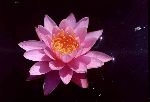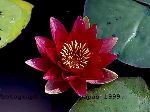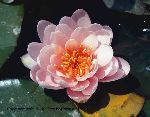Andreas Protopapas
Cyprus
The quest for the hardy blue
By Jacqueline Reditt
Originally published in "Cyprus Weekly" Christmas Edition 1989
Click images to enlarge
You can never tell by appearances. Andreas Protopapas is,
at face value, a mild-mannered, conventional man who earns his
living as the chief engineer of an offshore company based in
Nicosia. Yet, after his family, his abiding passion is - water
lilies. And while other men dream of making their first (or next)
million, a new car or scoring the winning goal for Cyprus in
the World Cup, Protopapas devotes himself to creating the world's
first "hardy blue".
It all began when he put a pond in his garden and started keeping goldfish. The pond, he decided, needed some water lilies. The fish went the way of all fish, but the water lilies flourished. Protopapas was enchanted by the beauty of their deep green, paddle-shaped leaves, and the delicacy of the brilliantly coloured flowers against the still dark water.
He is not, of course, the first to fall under the spell of these aquatic flora. Known to horticulturalists as Nymphae, they were named after the "semi-divine maidens inhabiting the sea, rivers and fountains" of Greek mythology. Legends tell of their power to induce dreaminess and delicious indolence, and the "lotus blossom", as its Oriental cousin is known, is an age-old symbol of beauty in the Far Eastern world of art.
Protopapas began a feverish search for water lilies in Cyprus. He managed to beg, borrow and steal a few from the odd garden pond. "The best place to see water lilies in Cyprus is at the Ayios Heracleidios monastery near Tamasscis", he says. "There is a large pond outside, with the yellow hybrid Marliacea Chromatella and a smaller pond inside the Nymphaea Comanche, a pink to red variable which was donated to the monastery. "
He began to read anything he could find on the subject, and it was then that the hobby turned into a quest for the potentially unattainable. Protopapas attributes this directly to a sentence in "Water Gardens for Plants and Fish" by Charles B. Thomas. "Perhaps you will develop a hardy blue water lily," says the author. "If you, incidentally, please get in touch with me. I would trade my coat and hat and practically anything else for such a gem."
Protopapas explains that there are two kinds of water lily - "tropical", which need warm water, and hardy, which can survive even when the water freezes. Tropical flowers come in all sorts of colours, including blue, but hardy water lilies are limited to white, yellow or pink and hybrids of these.
Most of the hybrids that have been developed were the work
of a Frenchman, Joseph Bory Latour-Marliac, who lived in the
late 19th century. He created well over one hundred new hybrids,
but never a blue. "Unfortunately he took the secrets of
his life's work to the grave", says Protopapas. "Apparently,
he was not only evasive about his techniques and the 'parentage'
of his hybrids, but on occasions he deliberately threw others
off the scent by giving them dubious information."
 |
 |
 |
|
|
||
Since then, little effort has been made to create new hybrids. Protopapas, however, found the challenge irresistible. "I found myself wondering 'Why shouldn't there be a blue?'", he says. Exhausting local supplies, he applied to the Department for the Protection of Plants for an import license to bring in the large numbers of species and hybrids he needed for his experiments. The first batch, including some from Kew Gardens, arrived in the spring of 1988.
He joined the British-based Water Lily Society - "a group of enthusiasts inspired by this beautiful flower" - and on a trip to England, he visited the Herbarium library and Royal Botanical Gardens at Kew, and the Stapely Water Gardens in Cheshire.
Back home, it was standing room only in the garden pond, and
the first priority was to make tanks to house more plants. These
quickly filled up the garden and he put additional tanks on the
roof - perhaps  the
only roof-based water garden in Cyprus. With most of his spare
time and large areas of the house and garden devoted to water
lilies, Protopapas counts himself lucky that his wife, Niki,
has shown a high degree of tolerance: "She wasn't too happy
about it in the beginning", he recalls "but when she
saw how beautiful the lilies were she too became interested in
them."
the
only roof-based water garden in Cyprus. With most of his spare
time and large areas of the house and garden devoted to water
lilies, Protopapas counts himself lucky that his wife, Niki,
has shown a high degree of tolerance: "She wasn't too happy
about it in the beginning", he recalls "but when she
saw how beautiful the lilies were she too became interested in
them."
He now has about 25 varieties of water lily in his tanks and pond and he has already begun cross pollinating them. The process calls for plenty of care and precise timing. The anthers that contain the pollen must be cut off the first day the buds opens to prevent self-pollination. Then the anthers from the flower it is to be crossed with, which must be in its second day of blooming, are gently pushed into the stigma. After that it is largely a matter of "wait and see" and further trials.
A dreamer he may be, but Andreas Protopapas has few illusions about his chances of of creating the elusive blue. "It would be worth thousands of pounds but, to be honest, the chances are remote." But he does have hopes for succeeding in the creation of a new hybrid in the near future, and he already has a name for it. "It will be called Nicoletta, after my wife."
Andreas' Gallery Index
Cyprus Mail features Protopapas
Andreas' Web Site
|
Water Gardening | Water Gardening Friends | New This Month Kit & Ben Knotts | Our Garden | Search The Site | Home |
